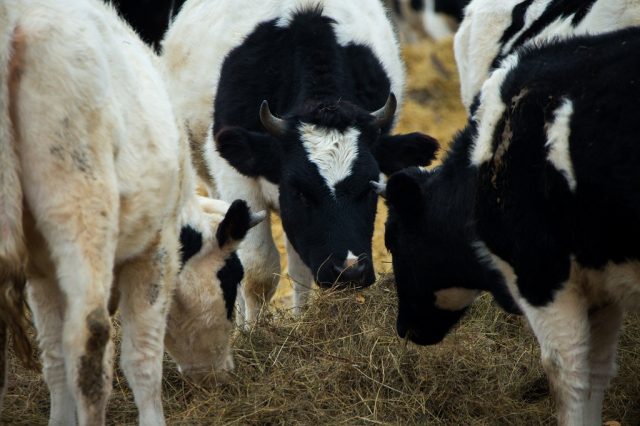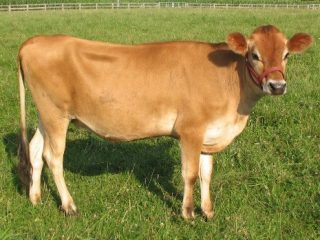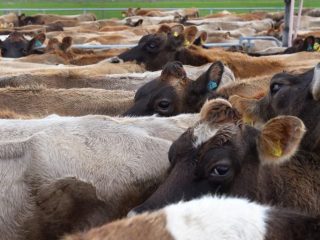Content [скрыть]
Any farmer wants his animals to have a high level of productivity. In this case, it is necessary to carry out breeding work and understand how to correctly evaluate cattle for productive qualities. Cattle grading is necessary in order to determine the necessary criteria as accurately as possible, as a result of which only valuable individuals remain in the herd.
What is cattle appraisal and why is it needed
Grading is an assessment of cattle, which allows you to determine their quality value, taking into account the breed, constitution, conformation, origin, live weight and milk production. As a rule, all the work is carried out by employees of the farm; they rarely invite outside specialists.
Before proceeding with the appraisal of cattle, you will need to complete a number of procedures:
- check the assigned animal number;
- take into account information on feeding and keeping individuals;
- fill out a special card - F2-mole;
- summarize the milk yield of each cow for the last year;
- carry out all the necessary preparatory work.
In order to classify cattle, the Ministry of Agriculture has specially developed an instruction, which describes in detail all kinds of distinctive features of livestock. After a complete assessment of cattle has been carried out, each animal is assigned an appropriate class.
How is appraisal carried out
Cattle grading can be carried out both by farm workers themselves and by experts invited from outside. All work, as a rule, is carried out in a certain sequence, after which the belonging of the animal is determined.
The sequence of work is as follows:
- the first step is to determine the breed of each individual, while the breed must be confirmed by official documents;
- each cow is given an estimate of the relative milk production;
- assess the constitution and exterior of the body;
- give a final assessment;
- assign a class.
After the assignment of the class, the further purpose of the workover is determined. In most cases, if an individual scored less than 50 points, then it is sent to slaughter.
Criteria for evaluation
After the assessment of cattle, the data obtained during the research are collected and checked against a special table.
Cows are scored according to the following criteria:
- milk productivity;
- body constitution;
- body exterior;
- genotype.
Bulls are assessed:
- genotype;
- body exterior;
- body constitution.
Young animals take into account:
- genotype;
- body exterior;
- body constitution;
- degree of development.
When assessing cattle, animals are assessed for all of the above parameters. Grades are assigned in accordance with the data presented in special tables. After that, the points are summed up, an overall assessment is obtained, after which the animal is assigned a class.
By origin
The first step is to carefully study the documentation on the origin of each individual, including the breed of the parents. The animal is examined, the type of breed is determined: a purebred individual or a cross.
Purebred, as a rule, are considered animals whose parents are of the same breed. In this case, there must be a documentary confirmation of the breed or a cross in the 4th generation also documented - the breed is clearly expressed, the class is not less than the elite. A cross includes individuals that were obtained by mixing several different species.
Exterior
In this case, the following indicators are taken into account in heifers:
- udder shape;
- suitability for automated milking;
- udder size;
- the severity of the breed;
- harmony of physique.
Bulls pay attention to:
- breed characteristics and their severity;
- hind limbs;
- harmony of physique;
- lower back.
After the inspection, each animal is evaluated on a scale from 1 to 10. In the process of assessing cattle, defects and deviations in each individual are taken into account. The exterior is assessed on a scale from 1 to 5. At the same time, only those animals that have:
- well developed withers in accordance with age;
- wide chest, no interception on the shoulder blades;
- straight sacrum, back, lower back;
- well-developed pelvis;
- legs are set correctly.
In cows, special attention is paid to the udder.
By live weight
When evaluating young animals, it is worth adhering to the additional table of the average daily weight gain of animals aged 8 to 15 months.
Points | Bulls | Heifers |
2 | Less than 700 g | Less than 560 g |
3 | 701 g to 850 g | 561 g to 560 g |
4 | 851 g to 1 kg | 651 g to 750 g |
5 | From 1 kg and more | 751 g and more |
In order for the information obtained to be subjective, it is required to weigh the animals daily and record the data in a book specially designed for this purpose.
By productivity
Productivity grading is usually carried out taking into account the quality and quantity of milk.
In this case, the following indicators are taken into account:
- the amount of milk yield in kg;
- fat content of milk in percent;
- milk delivery speed.
In the research process, a special table is used. It indicates the performance data that a cow must meet for 1, 2 and 3 lactation periods. Each individual is individually checked for compliance with this data.
At the same time, it is important to take into account that a control milking should be carried out monthly, after which the average fat content of the milk is calculated. In addition, it is worth taking into account the amount of milk received per day and the time spent on this.
Reproductive ability
When assessing reproductive characteristics, data obtained from livestock specialists and veterinarians are taken into account. When bulls are evaluated during grading, the number of standard sperm obtained throughout the year or the number of cows fertilized per mating season is taken into account. Cows are assessed by calving flow and the length of the calving period.
By the quality of the offspring
After the bull has reached the age of 12 months, it is put to check the offspring. During the inspection period, semen is taken from the bull every day, the resulting material is frozen. All tested bulls are used at the same time, while an equal number of cows are inseminated with the taken seed. The offspring obtained is recorded and checked for abnormalities in the calves.
Rating classes
After carrying out all the studies and calculating the total amount of data, the animals are assigned the appropriate class.
Today, there are the following classes assigned after the assessment of cattle:
- elite record - the animal scored more than 81 points;
- elite - the number of points ranges from 71 to 80;
- Grade 1 - varies from 61 to 70 points;
- 2nd grade - from 51 to 60 points;
- extracurricular - less than 50 points were scored.
As a rule, out-of-class animals are not recommended for breeding. In most cases, they are immediately sent for slaughter after grading, since such individuals are of no value.
Each animal has the opportunity to score up to 100 points.The maximum score for performance is 60, for constitution and exterior you can get up to 24 points and for genotype they give a maximum of 16 points.
Subsequent administration of animals
After all the necessary data have been obtained, the individual characteristics of each animal have been taken into account, you can proceed to determining the purpose of cattle.
The purpose of cattle is determined as follows:
- as a rule, only the best part of the herd belongs to the breeding nucleus. In most cases, this part does not exceed 60% of the total number of animals;
- breeding individuals included in the breeding core make up about 20% of the number of individuals that entered the broodstock after grading.
Among the animals that make up the breeding nucleus, mainly young heifers and gobies are selected. If the young do not have any breeding values, then they are fattened up and then sent for slaughter.
Conclusion
Cattle grading is a procedure according to the results of which the purpose of each animal on the farm is determined. The individuals with the highest indices form the breeding nucleus. Outstanding individuals are used to order mating, which is carried out to obtain breeding individuals. As a rule, these works can be carried out by the farm workers themselves, but if necessary, you can turn to professionals from the research institutes for help.










